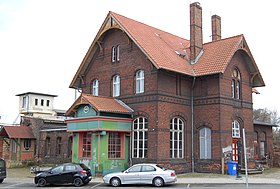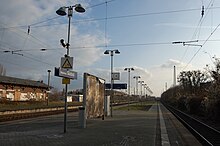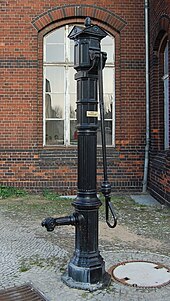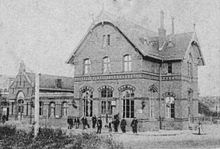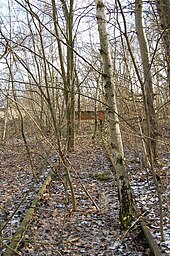Magdeburg Südost train station
| Magdeburg southeast | |
|---|---|
|
Magdeburg Südost train station
|
|
| Data | |
| Design | Through station |
| Platform tracks | 4th |
| abbreviation | LMSO |
| IBNR | 8012287 |
| Price range | 5 |
| Profile on Bahnhof.de | Magdeburg_Suedost |
| location | |
| City / municipality | Magdeburg |
| Place / district | Westerhüsen |
| country | Saxony-Anhalt |
| Country | Germany |
| Coordinates | 52 ° 4 '13 " N , 11 ° 40' 9" E |
| Railway lines | |
|
|
| Railway stations in Saxony-Anhalt | |
The Magdeburg Southeast Station is a train station at the Magdeburg-Leipzig Railway in Magdeburg district Westerhüsen . The actual station building, which is no longer used for station operations, is a listed building .
History and architecture
The construction of the railway line was on February 14, 1836 by Friedrich Wilhelm III. and the specific construction plan for the line was approved on November 13, 1837. The route was divided into 12 construction sections. Westerhüsen was part of the 2nd construction phase Buckau - Schönebeck (Elbe) . The actual start of construction in Westerhüsen took place on April 24, 1838. The construction team comprised 1 engineer, 3 supervisors and 150 to 320 civil engineering workers. By the end of August 1838, the railway bridge on Sohlener Strasse and the level crossing at the old Westerhüsen cemetery were largely completed. The railway bridge was made of wood and was framed by a wooden plank. The owners of the land over which the route ran were compensated. The windmill Grabau received 600 thalers because the railway line cut the access road to his windmill.
In the area of Westerhüsen, considerable earth movements were necessary during construction. A total of 125,181 m³ of earth was moved in the local area of Westerhüsen. At bridges and culverts 2783 m³ of masonry were built. Since the masses of sand and earth occurring in Westerhüsen were used as a substructure at other points along the route, work in the Westerhüsen area was initially suspended in the summer of 1838 and continued at other points along the route.
The first train then ran on June 29, 1839. It had 13 carriages and was pulled by an Adler locomotive. The journey started at 8.15 a.m. from the Fürstenufer in Magdeburg. The train is said to have arrived at the destination station in Schönebeck just 25 minutes later. The return journey began at 10.30 a.m. On Sunday, June 30th, 1839 the route was opened to public traffic. There were then initially three trips a day in the morning and three in the afternoon. The Adler and Jungfer locomotives were used as locomotives . A total of 2190 passengers could be transported every day. Presumably there was a stop in Westerhüsen from the beginning.
A first fixed stop created after completion of the railway Magdeburg-Halle / Leipzig, however, at least 1840 at which the path from here between the villages Westerhüsen and Salbke, at the location Beyendorf and soles on the main road to Magdeburg and in that space coaching met . This building, described as a shack, was east of the railway line. In 1850, a massive station house was built north of today's Welsleber Strasse in the Salbker district. The building that was not preserved stood west of the railway line. In 1868 a station building was built south of the street and thus on the Westerhüser district. A goods shed was added in 1884.
Various guards' houses stood along the railway line . One was at the level crossing near the old cemetery, but it was demolished in 1894. Another, later demolished, was located at the former level crossing to the new cemetery on Holsteiner Strasse. Above the embankment at the Bodenburg windmill stood a station keeper's house without a level crossing. The job of the station attendant was to check the route, which was regularly necessary in view of the not yet so firmly fixed rails. A corresponding house at the southern end of Volkspark Westerhüsen was known as Bude 6 . A last corresponding building was located directly on the southern border of the Westerhüser district to Frohse.
In 1894 the line was expanded by two tracks. The bridge on Sohlener Strasse also had to be extended. Due to the larger space requirement, the old station building had to be demolished. Today's Cafe Kies is a copy of the demolished station building and was created using the original components of the old station. The route of the railway was increased significantly, so that the underpass still existing under the railway structure was necessary. At the same time, today's Welsleber Straße was relocated to the north.
The current station building was then built in 1894 and 1895. It has largely been preserved in its original design and represents a one-and-a-half-storey clinker brick type building of the Prussian State Railways , as was customary for the reception buildings of train stations of subordinate stations. In the urban area of Magdeburg, besides the Magdeburg-Neustadt train station , it is the only remaining station building from the time of the Prussian state railway. The facade is intricately structured. Both segment-arched and pointed arched window openings were used. The gables are decorated with wood. The building is covered by a gable roof that protrudes in a striking way. On the west side there is a central projection . On the north and south gable ends there are smaller extensions that served as a vestibule or toilet wing.
Due to the location of the station near the boundary of the district, disputes arose between the communities of Salbke and Westerhüsen, which were still independent until 1910, about the naming of the station. After it was initially run as Westerhüsen station until 1909 , the name Westerhüsen-Salbke emerged until 1913 , according to another indication Salbke-Westerhüsen , until then, probably from 1914, today's name Magdeburg Südost was introduced. However, on a map from 1916 there is still the indication of Westerhüsen-Salbke . The Westerhüser master painter Weytag had the order to adapt the station signs to the changed names. During the First World War , the number of train connections on offer decreased. While 52 trains stopped at the station as scheduled in 1914, the number had fallen to 39 in 1917. On February 16, 1921 there was a fatal accident at the train station. The shunter Willi Stein got between the buffers, where he suffered severe bruises in his chest, which he died of shortly afterwards in the hospital.
In 1934 the line was electrified . At the same time, the curves of the tracks in the Westerhüsen district were flattened and the wooden bridge on Sohlener Straße was replaced by a concrete bridge. There was considerable earth movement. Today's retaining wall on Holsteiner Strasse was built on the west side of the route.
Since the opening of the Magdeburg S-Bahn on September 29, 1974, the train station has been an S-Bahn station.
For a long time there was a stork's nest on the building .
The station is in operation. However, the station building was converted. In the 1990s there was a gastronomic use by a Klapperstorch restaurant . After a long period of vacancy, the building is used for residential purposes and as a workshop for steel sculptor Joachim Röderer . In front of the station building there is a historical water pump , which was temporarily listed as a small monument , but is no longer entered in the monument register after deletion. The use of the freight yard was discontinued. In particular, the tracks leading east towards the former Fahlberg-List chemical plant are overgrown and overgrown with trees.
Anecdotal
The story of an old Westerhüser farmer has been handed down from the day of the first train ride. With the words "Ick gah na de Isebahne I want to piss me off" he went to the train station Westerhüsen, which was actually there on the first day. In order to observe the expected train, he stood in the middle of the rail, whereupon an officer asked him to leave the rails. The old man from Westerhüsen replied: “Well, I’ll be able to defend mick dat here.” And stopped on the tracks. The officer forcibly removed him from the track. Shortly afterwards the train came. Thereupon the farmer left, shaking his head. For the incident he was later given a sentence of eight days in prison or a fine of three talers, which he calmly accepted. One morning he put on his Sunday suit and said to his wife: “Can you forge a bag? I want to wrap mick in the Daug.” “Vadder, where do you want to go?” He: “Well, I thought that would be now want to de Tid, datt ick datt afsitten ”. His wife was horrified: “You weren't vadder datt. I have already paid for the 3 Daler for a long time. "" Watt, jie infamous goods, 3 Daler dumped me window rests, not ick hew but soveel Tid, that ick can sit down. "
Transport links
| line | Line course | Tact | EVU |
|---|---|---|---|
| RE 30 | Magdeburg - Magdeburg southeast - Schönebeck (Elbe) - Calbe (Saale) - Köthen - Halle (Saale) | 60 min | DB Regio Southeast |
| S 1 | Schönebeck-Bad Salzelmen - Magdeburg southeast - Zielitz - Tangerhütte - Stendal - Wittenberge |
30 min (Schönebeck – Zielitz) 60 min (Zielitz – Wittenberge) |
DB Regio Southeast |
literature
- Marta Doehler, Iris Reuther : Settlement development in Westerhüsen Magdeburg southeast . State capital Magdeburg 1995, page 24
- Friedrich Großhennig, Ortschronik von Westerhüsen in the Magdeburg-SO district , manuscript in the Magdeburg city archive, signature 80 / 1035n, Part II, page 55 ff.
- Monument Directory Saxony-Anhalt, Volume 14, State Capital Magdeburg , State Office for Monument Preservation and Archeology Saxony-Anhalt, Michael Imhof Verlag, Petersberg 2009, ISBN 978-3-86568-531-5 , page 550 f.
Web links
Individual evidence
- ↑ Query of course book route 340 at Deutsche Bahn.
- ^ Friedrich Großhennig, Ortschronik von Westerhüsen in the Magdeburg-SO district , manuscript in the Magdeburg City Archives, call number 80 / 1035n, Part II, page 60
- ↑ a b c Doehler, Reuther, settlement development in Westerhüsen , page 24
- ↑ a b List of monuments, Magdeburg, page 550
- ↑ Magdeburg in the First World War 1914 to 1918, Eine Großstadt auf der Heimatfront , Ed .: Maren Ballerstedt, Gabriele Köster, Maik Hattenhorst, Mitteldeutscher Verlag Halle (Saale) 2014, ISBN 978-3-95462-307-5 , page 237
- ↑ Between the buffers In: Volksstimme . February 20, 1921.
- ↑ Marta Doehler, Iris Reuther: Settlement development in Westerhüsen Magdeburg southeast . State capital Magdeburg 1995, page 156
- ↑ Friedrich Großhennig, Ortschronik von Westerhüsen in the Magdeburg-SO district , manuscript in the Magdeburg City Archives, signature 80 / 1035n, Part II, page 58 ff.
- ↑ Olaf Meister , local sagas from Westerhüsen and the surrounding area , epubli Berlin 2019, ISBN 978-3-748572-28-2 , page 80 ff.
